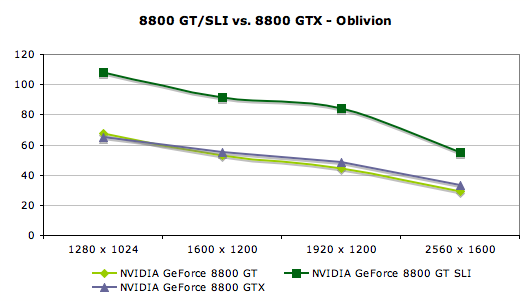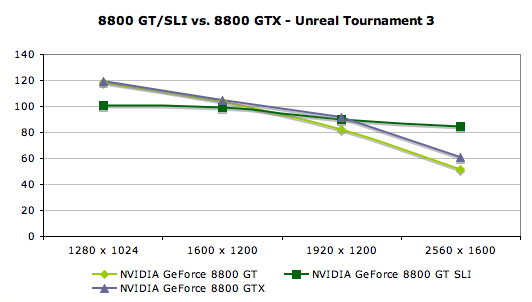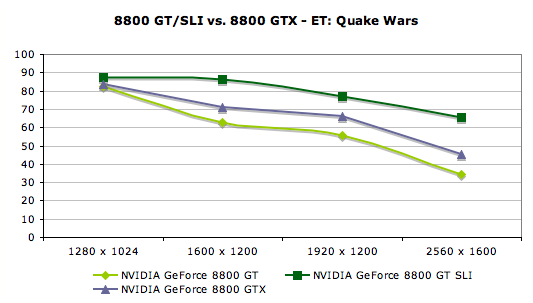NVIDIA GeForce 8800 GT: The Only Card That Matters
by Derek Wilson on October 29, 2007 9:00 AM EST- Posted in
- GPUs
GeForce 8800 GT MultiGPU Scaling
It will still be quite a while before we see multiGPU solutions provide the stability and consistency of a single GPU. For those interested, though, NVIDIA has left enough of an opening in their product line up this time around that SLI actually makes sense as a high end solution rather than just a potential upgrade path.




With the elimination of the 8800 GTS lineup, and the fact that performance of the 8800 GT is much faster than half the speed of the 8800 GTX, 8800 GT SLI looks pretty good under games that scale with SLI. Not only that, but 2x 8800 GT cards will cost, at most, as much as an 8800 GTX. Once the price of the 8800 GT approaches $200, as we expect it to, the price of a solution faster than the 8800 GTX will be available for much less money.
We do have to keep in mind that not everything scales with SLI, and we still have the occasional minor problem with stability or consistency. The scaling issue can be eased through the use of SLIAA in games that are able to benefit.
It will still be quite a while before we see multiGPU solutions provide the stability and consistency of a single GPU. For those interested, though, NVIDIA has left enough of an opening in their product line up this time around that SLI actually makes sense as a high end solution rather than just a potential upgrade path.




With the elimination of the 8800 GTS lineup, and the fact that performance of the 8800 GT is much faster than half the speed of the 8800 GTX, 8800 GT SLI looks pretty good under games that scale with SLI. Not only that, but 2x 8800 GT cards will cost, at most, as much as an 8800 GTX. Once the price of the 8800 GT approaches $200, as we expect it to, the price of a solution faster than the 8800 GTX will be available for much less money.
We do have to keep in mind that not everything scales with SLI, and we still have the occasional minor problem with stability or consistency. The scaling issue can be eased through the use of SLIAA in games that are able to benefit.










90 Comments
View All Comments
Spacecomber - Monday, October 29, 2007 - link
It's hard to tell what you are getting when you compare the results from one article to those of another article. Ideally, you would like to be able to assume that the testing was done in an identical manner, but this isn't typically the case. As was already pointed out, look at the drivers being used. The earlier tests used nvidia's 163.75 drivers while the tests in this article used nvidia's 169.10 drivers.Also, not enough was said about how Unreal 3 was being tested to know, but I wonder if they benchmarked the the game in different manners for the different articles. For example, were they using the same map "demo"? Were they using the game's built-in fly-bys or where they using FRAPS? These kind of differences between articles could make direct comparisons between articles difficult.
spinportal - Monday, October 29, 2007 - link
Have you checked the driver versions? Over time drivers do improve performance, perhaps?Parafan - Monday, October 29, 2007 - link
Well the 'new' drivers made the GF 8600GTS Perform alot worse. But the higher ranked cards better. I dont know how likely that isRegs - Monday, October 29, 2007 - link
To blacken. I am a big AMD fan, but right now it's almost laughable how they're getting stepped and kicked on by the competition.AMD's ideas are great for the long run, and their 65nm process was just a mistake since 45nm is right around the corner. They simply do not know how to compete when the heat is on. AMD is still traveling in 1st gear.
yacoub - Monday, October 29, 2007 - link
"NVIDIA Demolishes... NVIDIA? 8800 GT vs. 8600 GTS"Well the 8600GTS was a mistake that never should have seen the light of day: over-priced, under-featured from the start. The 8800 GT is the card we were expecting back in the Spring when NVidia launched that 8600 GTS turd instead.
yacoub - Monday, October 29, 2007 - link
First vendor to put a quieter/larger cooling hsf on it gets my $250.gamephile - Monday, October 29, 2007 - link
Dih. Toh.CrystalBay - Monday, October 29, 2007 - link
Hi Derek, How are the Temps on load? I've seen some results of the GPU pushing 88C degrees plus with that anemic stock cooler.Spacecomber - Monday, October 29, 2007 - link
I may be a bit misinformed on this, but I'm getting the impression that Crysis represents the first game that makes major use of DX10 features, and as a consequence, it takes a major bite out of the performance that existing PC hardware can provide. When the 8800GT is used in a heavy DX10 game context does the performance that results fall into a hardware class that we typically would expect from a $200 part? In other words, making use of the Ti-4200 comparison, is the playable performance only acceptable at moderate resolutions and medium settings?We've seen something like this before, when DX8 hardware was available and people were still playing DX7 games with this new hardware, the performance was very good. Once games started to show up that were true DX8 games, hardware (like the Ti-4200) that first supported DX8 features struggled to actually run these DX8 features.
Basically, I'm wondering whether Crysis (and other DX10 games that presumably will follow) places the 8800GT's $200 price point into a larger context that makes sense.
Zak - Monday, November 5, 2007 - link
I've run Vista for about a month before switching back to XP due to Quake Wars crashing a lot (no more crashes under XP). I've run bunch of demos during that month including Crysis and Bioshock and I swear I didn't see a lot of visual difference between DX10 on Vista and DX9 on XP. Same for Time Shift (does it use DX10?). And all games run faster on XP. I really see no compelling reason to go back to Vista just because of DX10.Zak